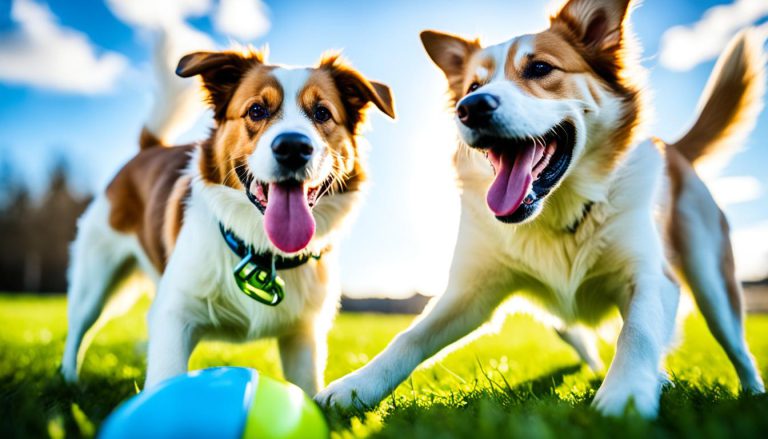Have you seen your dog looking sad? Like people, dogs can feel sadness and grief. They might not get depressed like we do, but they can still feel down. It’s important we find ways to cheer them up and get their tails wagging again.
In this article, I’ll show you how to lift your dog’s spirits, for puppies and adult dogs alike. We’ll look at the signs of a dog feeling down, figure out how to understand their feelings, and share tips to make them happy. We’re going to talk about playing together, making their space cozy, and other steps to help them feel better. Let’s get started and add some joy to their day!
Key Takeaways:
- Recognize the signs of depression in dogs, such as changes in appetite and behavior.
- Engage in interactive play to provide mental and physical stimulation.
- Create a comfortable environment with a cozy bed and calming scents.
- Ensure socializing and companionship for your dog’s emotional health.
- Regular exercise and outdoor activities help boost their mood.
Recognizing Signs of Sadness
Seeing signs of sadness in dogs helps us understand what they feel. Like us, dogs can be sad or depressed. We must watch their behavior closely.
Look out for these signs:
- Dogs may eat less if they’re sad or depressed. A sudden eating habit change is a big clue.
- If your dog sleeps more or seems tired, they might be sad. More napping than usual is a sign.
- Sad dogs may want more hugs or attention. Seeking more love could mean they try to feel better.
- A dog missing a friend may stay in spots that remind them of their buddy. This shows their sadness.
- Sad dogs may become quieter or whine more. Any change in how they “talk” might mean they’re not happy.
| Signs of Sadness | Description |
|---|---|
| Aggressive behavior | Dogs might get aggressive if sad or depressed. This could look like growling or snapping when they feel stressed. |
| Inappropriate elimination | Sad dogs might have accidents inside. This behavior can be a stress response or show they’re upset. |
| Withdrawal from social situations | Dogs may avoid others and want to be alone if they’re sad. They might skip interactions with pets or people. |
| Hiding | Sad dogs often hide. They may find secret spots in the house or sneak under furniture to be alone. |
| Increase in destructive behaviors | Sad or anxious dogs might chew or scratch things more. These acts can come from their emotional pain. |
| Disinterest in normal play activities | A sad dog may not care about playtime or toys. They could ignore things that used to make them happy. |
Remember, these signs might show sadness or something else health-related. If these behaviors last or get worse, seeing a vet is wise. They can give the right diagnosis and help.
Engaging in Interactive Play
Playing with your dog is a great way to make them happy. It helps their mind and body stay active. Fun games can make them feel less sad and lonely. They also make your bond with your furry friend stronger.
Looking for playtime ideas? Here are some:
- Playing Fetch: This fun game gets your dog moving. Use their favorite toy or a ball for them to chase and bring back.
- Going for Walks: Walks are good for exercise and exploring new things. It’s a chance for your dog to see, hear, and smell the world around them.
- Participating in Agility or Obedience Training: Training activities challenge your dog’s brain. They feel proud when they master new skills or commands.
- Using Puzzle Toys or Treat-Dispensing Toys: These toys make your dog think. They need to solve puzzles to get treats, which keeps them busy for hours.
- Socializing with Other Dogs: Playdates or visits to a dog park let your dog meet others. This helps their mood and gives them friends to play with.
Remember, choose activities that fit your dog’s age, breed, and health. This ensures they have fun and stay safe.
| Benefits of Interactive Play | Keywords |
|---|---|
| Enhances mental stimulation and problem-solving skills | mental stimulation, problem-solving skills |
| Provides physical exercise and helps burn off energy | physical exercise, burn off energy |
| Strengthens the bond between dog and owner | strengthen bond, dog and owner |
| Alleviates feelings of sadness and loneliness | alleviate sadness, alleviate loneliness |
Playing with your dog is good for them and for you. It makes you both happy. So, grab their favorite toy and enjoy your time together.
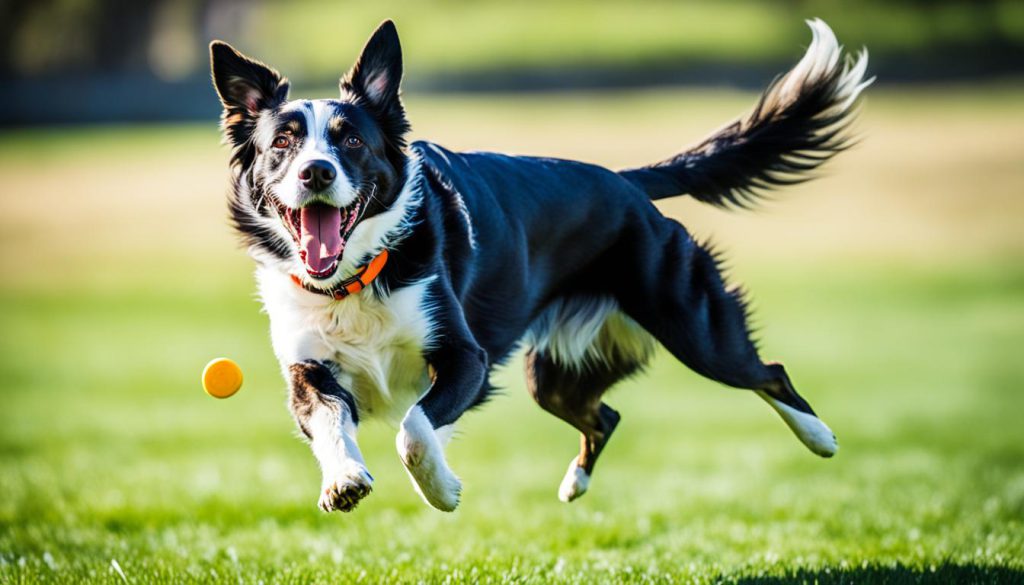
Creating a Comfortable Environment
Making a comforting space is key to helping a sad dog. A safe and cozy area can ease their anxiety. It lets them relax. Here are some ideas to help your pet feel better:
Provide a Cozy Retreat
Dogs need their own quiet spot to unwind. Give them a soft bed or a den-like area to feel protected. This special nook will be their go-to place for quiet times.
Utilize Pheromone Diffusers and Calming Scents
Using pheromone diffusers or calming scents works well for sad dogs. They release natural smells similar to those from a mother dog. These scents can soothe their stress, making the space peaceful.
Ensure a Quiet and Calm Atmosphere
It’s important to keep the environment calm for your sad dog. Try to reduce loud sounds and sudden disruptions. A peaceful setting helps them find comfort and peace.
Establish a Routine
Routine helps dogs feel stable. A consistent schedule gives them comfort and eases their worry. Set regular times for meals, play, and rest. Such predictability supports their emotional health.
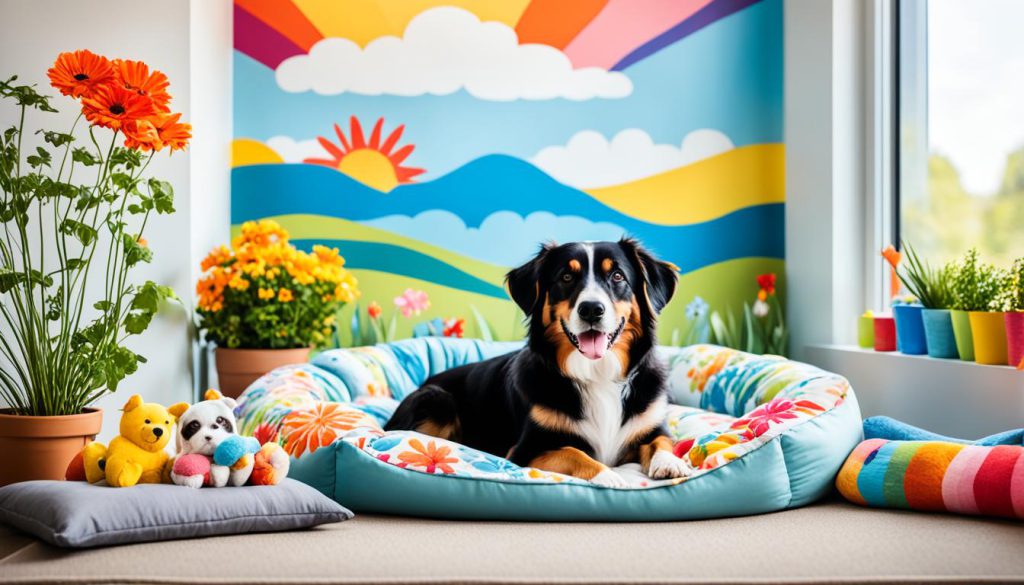
By implementing these tips, you can make your dog feel protected and happy. A tranquil environment is crucial for their emotional health. It greatly contributes to their joy.
Socializing and Companionship
Dogs need friends just like we do. They’re social animals and love being around others. Giving them chances to make friends can make them feel better if they’re sad.
Setting up playdates is a great way to help your dog socialize. This lets them have fun and interact with other dogs. You can take them to dog parks or events where dogs are welcome. This way, they can meet lots of different dogs.
Introducing a New Pet
Getting a new pet might also cheer up your dog. Having a friend around can make them happy and give them something to do. But, you should think about how they get along with others and any special needs they have before getting another pet.
“Getting a new friend for a sad dog can be really helpful. But, we need to make sure they’ll get along. It’s all about keeping both pets happy.” – Dr. Emily Johnson, Veterinarian
When you bring home a new pet, take it slow. Begin with short times together under your watch. This helps your dog get used to the newcomer. Make sure each pet has its own space and things. This can prevent fighting and help them become friends.
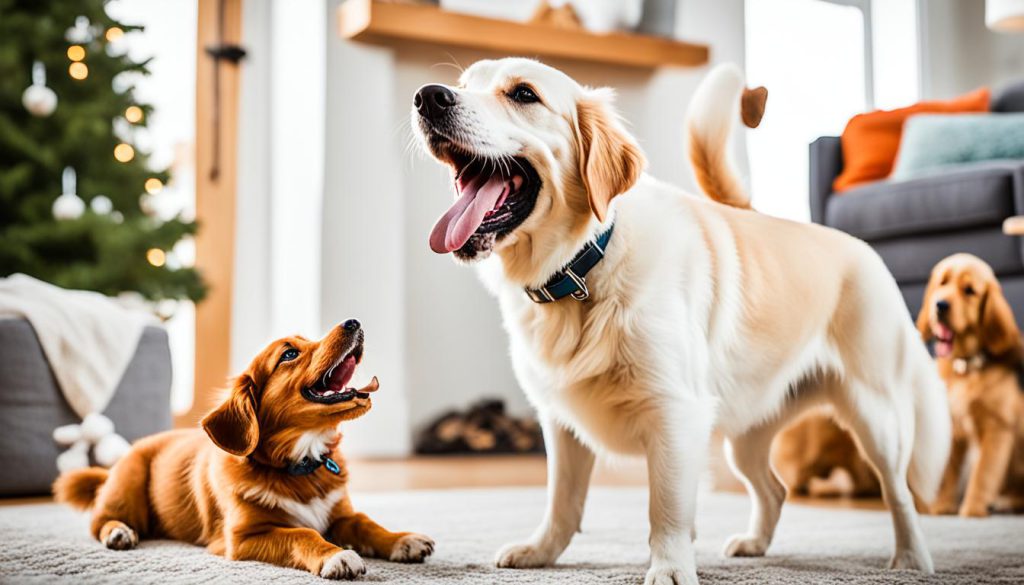
It’s good to remember that all dogs are different. They might need time to get used to a new friend. With lots of love, patience, and help, they can become the best of friends.
Regular Exercise and Outdoor Activities
Regular exercise and outdoor activities are key for a dog’s happiness and emotional health. These activities keep them fit and uplift their mood. Whether your dog is feeling down or you just want to keep them happy, exercise is important.
Taking your dog for regular walks is one effective exercise. Walks provide both physical activity and mental stimulation. They let your dog explore, meet other dogs, and interact with people, lifting their spirits.
Exercise releases endorphins, natural chemicals that boost mood. This helps make dogs happier and less likely to feel sad or depressed.
Outdoor activities like hiking, running, or fetch are also great. They offer intense exercise and fun for your dog. Make sure the activity level is right for your dog’s age and health.
Swimming: A Refreshing and Mood-Boosting Activity
Swimming is a wonderful activity for dogs. It’s easy on their joints and perfect for warm climates. It cools them down and is enjoyable.
Doing activities dogs enjoy, like swimming, positively affects their happiness. Happy dogs lead fulfilled lives.
Dog sports or obedience training can be fun and challenging. They help your dog learn, stay fit, and feel confident. Start these activities slowly and adjust to your dog’s abilities.
Adding exercise and outdoor fun to your dog’s daily routine boosts both their physical and emotional health. Always check with a vet to pick safe activities for your dog. Their safety and joy should always come first.
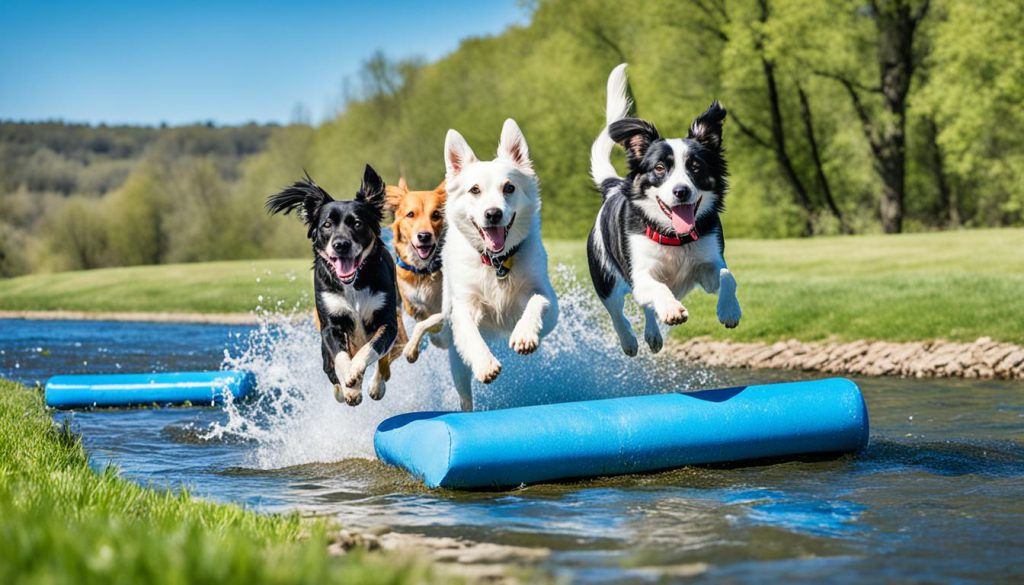
Consultation with a Vet or Behaviorist
If your dog stays sad or gets worse, it’s time to get expert help. Seeing a vet or behaviorist can give you insights into what your dog is feeling. They can help find the right way to make your dog feel better.
Vets are skilled in checking your dog’s health and finding if illness is causing the sadness. They can suggest ways to change behavior, give medicine if needed, and offer extra support for your dog’s feelings.
Behaviorists know a lot about why animals act the way they do. They give professional advice and tips for dealing with dog sadness. They look at your dog’s actions and where they live, suggest changes, and help with training.
Getting professional advice means your dog gets care that’s just for them. A vet or behaviorist can come up with a plan that deals with the reasons behind your dog’s sadness. This plan can help your dog become happy and lively again.
When should you consider seeking professional help?
If your dog stays sad for a long time or it affects their everyday life, you should see a professional. Here are some signs that it’s time to get help:
- Severe and persistent changes in appetite or weight loss
- Marked increase in sleep or lethargy
- Aggressive behavior towards people or other animals
- Inappropriate elimination or excessive vocalization
If you see any of these signs, it’s important to talk to a vet or behaviorist. They can help make sure your dog’s feelings get better and stop their mental health from getting worse.
Why seek professional help?
Talking to a professional can give you benefits even if you’ve tried to cheer up your dog on your own:
- Expertise: Vets and behaviorists know a lot about dog depression. They offer care and advice that fits your dog’s needs.
- Medical evaluation: A vet can check thoroughly for health problems that might make your dog sad. This ensures your dog gets complete care.
- Behavioral intervention: Behaviorists are great at figuring out animal behavior. They can suggest specific changes to help your dog feel better emotionally. They help change behaviors and use strategies for a happier mindset.
- Medication, if necessary: Sometimes, meds might be needed for your dog’s depression. A vet can give the right meds and check how well they work, making sure your dog is on the path to happiness.
Remember, asking for professional help shows you care deeply for your dog. It’s a step towards making sure they are happy and healthy.
Conclusion
Dogs can feel sad just like people do. It’s up to us to help them feel better. We can spot when they’re down, play with them, and make sure they’re comfy. We should also keep them active and seek professional advice if needed.
Remember, every dog is different. It might take time to see what works best. But with care and patience, we can make them happy again. Helping a dog through tough times is important for their happiness.
By understanding their emotional needs, we can make a big difference. Let’s work together to make our dogs and ourselves happier. Creating a happy space for our dogs lets them enjoy life more.

